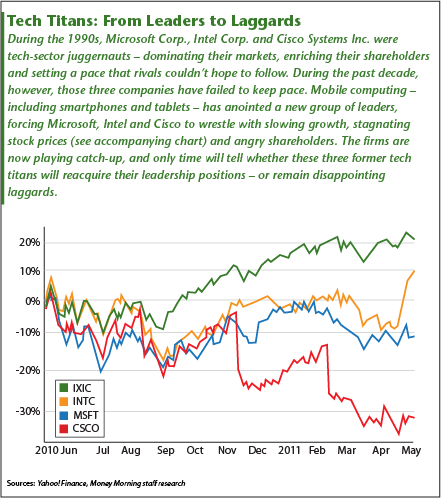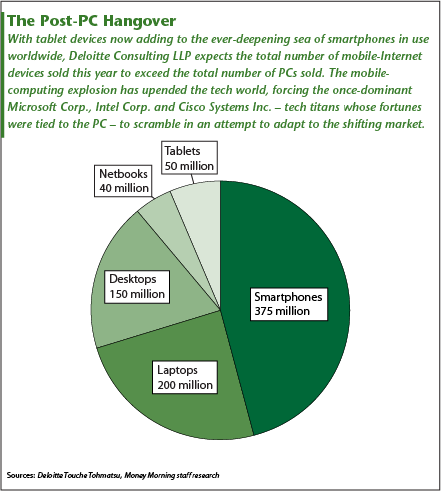For most of the 1990s, U.S. high-tech heavyweights Microsoft Corp. (Nasdaq: MSFT), Intel Corp. (Nasdaq: INTC) and Cisco Systems Inc. (Nasdaq: CSCO) didn't just dominate their respective markets.
They ruled them.
Microsoft's Windows operating system ran more than 95% of the world's PCs, and its word-processing and spreadsheet programs accounted for an estimated 95% of the market for office-applications software. The company was a constant target of state, federal and overseas governments, which tried in vain to break - or at least slow - the monopolistic juggernaut.

Intel, the other half of the so-called "Wintel" duopoly, had its chips in more than 90% of the world's PCs. Its identity was so strong that - by stamping "Intel Inside" on the beige PC cases - the company was able to "brand" what might otherwise have been a commodity product.
And Cisco was acknowledged as the backbone of the Internet, a key reason that - back in March 2000, with a market cap of $555.4 billion - it became the most valuable company on earth.
Throughout the 1990s, the shares of all three companies performed as the "must-own" stocks that they were: Microsoft's shares rose more than 9,000%, Intel's 10,000% and Cisco's 66,000% during that 10-year stretch.
But in the decade that followed the "dot-com" crash, those once-invincible leaders have been transformed into miserable laggards - and have become the focus of shareholder scorn.
Over the last 10 years, while the Nasdaq Composite Index rose about 34% and the Standard & Poor's 500 Index 8%, Microsoft has slumped 25%, Intel 15% and Cisco 12.5%.
"That's where money goes to die - all three of those stocks. I have no reason to own them," OptionMONSTER co-founder Jon Najarian told CNBC during a discussion of the trio's long history of poor returns.

Microsoft, Intel and Cisco ... and Wal-Mart Disease.
Unfortunately, as bad as things have been for these three struggling high-tech heavyweights, there are no obvious near-term fixes in sight. In fact, the challenges that Microsoft, Intel and Cisco now face are actually intensifying.
Take the whole "mobile-Web" push, in which boxy PCs and even notebook computers are being pushed to the sidelines by tiny netbooks, "tablets" and smartphones. Microsoft and Intel built their businesses around the PC - a market they controlled - and haven't been able to adapt their clunky computer-oriented strategies to this new realm.
Cisco focused on the network - the Internet itself. But its sales and traditionally fat profit margins have been squeezed because of cuts in government spending and intensifying competition from such rivals as Juniper Networks Inc. (NYSE: JNPR) and the Hewlett Packard Co. (NYSE: HPQ).
The upshot: The high-tech "Big Three" have seen their stock-price struggles deepen.
While the Nasdaq has risen about 27% in the past year, Microsoft shares are down about 10% and Cisco about 29%. Intel's stock price has shot up to about 10% in recent weeks after posting strong earnings, but prior to that was down about 10%.
Adding to the challenge is the legacy of past success. Each company has become so large, and controls such an overwhelming portion of its market, that significant growth has become exponentially more difficult.
Consultant Adam Hartung has coined a term for very large, successful companies that stagnate: He calls it Wal-Mart Disease. Global retailing giant Wal-Mart Stores Inc. (NYSE: WMT), the syndrome's namesake, is a onetime Wall Street darling whose heft (it's actually the largest private employer in the U.S. economy) has led to a massive deceleration in its growth rate. And its stock price has essentially done nothing for a decade.
"It's an obsession with sticking to the core business, and doing everything possible to defend and extend it - even when rates of return are unacceptable and there is a constant struggle to improve valuation," Hartung said. "You forget your prime objective is to grow the investment. Not just execute. Not just expand with more of the same by constantly trying to enter new markets - such as Europe or China or Brazil."
Mobile-Computing Miscues
Although Microsoft, Intel and Cisco have, in aggregate, spent billions attempting to expand into the mobile-computing realm, they have almost nothing to show for it.
Rivals have repeatedly beat them to market - and usually with products that are cheaper, more efficient, and more in tune with current market demands. None of the companies are in danger of going out of business, but neither has any of the three yet managed to craft a strategy to navigate the transition to mobile computing - without losing major market share.
And they're running out of time. Consulting firm Deloitte LLP has projected that 2011 will be the first year that combined sales of tablets and smartphones will exceed those of PCs.

What's more, Deloitte's 2011 report on technology predictions says a major consequence of the transition will be a much more diverse playing field.
"When looking at the future of computing devices, 2011 may well mark the tipping point as we move from a world of mostly standardized PC-like devices containing standardized chips and software to a far more heterogeneous environment," the report stated.
And that means that the risk of getting left behind - to the point where catching up will be impossible - is growing with each passing quarter.
"We have an extreme focus on the innovation of LePad and LePhone because these products will dominate the future market," Lenovo Group Ltd. (PINK ADR: LNVGY) Chairman Liu Chuanzhi told Bloomberg News in January. "Anyone who loses this battle will be phased out from the history of this industry."
But even if Microsoft, Intel and Cisco succeed in developing viable strategies, these three old-guard-techs have virtually no chance of dominating mobile computing as they did the PC-centric universe.
"Wintel" Woes Hit Microsoft ...
Microsoft's ubiquitous Windows operating system saw its market share peak at about 97.5% of that software segment in the early 2000s; even now, by most accounts, Windows market share still exceeds 90%.
But the PC market, which saw its annual growth rate peak at 42% in 1994, advanced at just a 13% clip last year. Smartphones and tablets are now the high-growth markets. The smartphone market is growing at a 32% pace, while tablet sales are growing 72% annually.
The Windows operating system runs on fewer than than 5% of smartphones and almost no tablets.
And Microsoft's path won't get any easier. Microsoft faces no fewer than four mobile operating systems, two of which are already well established: Apple's iOS and the Google Inc. (Nasdaq: GOOG) Android OS. The other two, the QNX OS marketed by Research in Motion Ltd. (Nasdaq: RIMM) and Hewlett Packard's WebOS, face an uphill battle themselves. But their mere existence will intensify the scrum for mobile-software dominance.
... And Intel
Similarly, Intel's so-called "x86" chip architecture runs about 80% of the world's PCs, but very few mobile devices. Chips made by companies licensing technology from rival ARM Holdings PLC (Nasdaq ADR: ARMH) power 75% of all mobile devices and 95% of smartphones, leaving little for Intel's Atom mobile chip.
And bruising competition from other tech heavyweights - essentially a non-issue in their respective PC markets - awaits Intel and Microsoft as they venture into mobile computing.
"Unlike the netbook phenomenon in 2009, where buyers chose machines that were essentially less-powerful versions of traditional PCs, the 2011 computing market will be dominated by devices that use different processing chips and operating systems than those used for PCs over the past 30 years," the Deloitte report states.
Historically speaking, in its core-PC business, Intel really only ever had to spar with Advanced Micro Devices Inc. (NYSE: AMD), a company that seems to alternate between extreme feast-or-famine modes. AMD's share price is currently below the $9 level - (well below its $44 peak of 2000, or $40 peak in 2006 - two highs that were separated by a $3.50-a-share trough in 2002).
But in the world of mobile chips, many formidable companies have adopted ARM's technology, including Apple Inc. (Nasdaq: AAPL), Samsung Electronics Ltd. (PINK: SSNLF) and Qualcomm Inc. (Nasdaq: QCOM). Some design the chips; others fabricate them, but ARM's licensing model means that Intel will have to fight its way through a gauntlet of rivals to achieve a high-ground position in this newer-and-faster-growing mobile market.
Stagnation at Cisco
Cisco, which controls about two-thirds of the router and switching market (the behind-the-scenes gadgets that make networks function), faces a somewhat more complicated challenge from the rise of mobile computing.
Mobile devices have changed how data flows on networks - particularly on the Internet, which is the biggest network of all. Cisco's core technology - the "static," or fixed-path network, is less-than-optimal in dealing with the unpredictable and chaotic traffic generated by mobile devices.
The business changed, too. Rivals like Juniper Networks Inc. (NYSE: JNPR) and Hewlett-Packard Co. (NYSE: HPQ) got a head start on Cisco and began to offer a much more flexible alternative known as a "unified network platform," or UNP.
While Cisco has lost only a little market share, the company has seen its once-stratospheric margins pressured by competitors offering equipment at lower prices.
Even now, margins on Cisco's switching and router businesses - which account for a combined 62% of its revenue - are at 75% to 80%. But its competitors are accepting margins of 50%, 40% or less - meaning that additional profit-margin squeezes may be in the offing.
That's going to hurt revenue growth, which is already hard to come by when your revenue is measured in billions of dollars - the curse of long-term success. Cisco generates more than $10 billion per quarter.
That's another problem common to all three tech giants; Intel has quarterly revenue of $12 billion, Microsoft $16 billion.
Even sustaining revenue at those levels can be challenging, much less increasing it. Major growth usually can come only by expanding into new markets, as Apple did with the iPhone.
Mobile computing offers such an opportunity, but each company has arrived a bit too late to the party to achieve the utter dominance that fortified their growth in the 1990s.
With continued dominance a virtual impossibility, what sort of future awaits these companies?
Perhaps the best-case scenario is to evolve either into a less influential but still successful player as International Business Machines Corp. (NYSE: IBM) did after its fall from power in the early 1990s. Other options are less pleasant: near irrelevance, as occurred with AOL Inc. (NYSE: AOL); or absorption, the fate of Sun Microsystems.
To find out what Microsoft, Intel and Cisco are doing to cope with the seismic shifts in their markets, continue reading this Money Morning multi-day series, which will cover each company's individual challenges in detail.
The series consisted of an overview story, followed by an in-depth analysis of each company. The Intel analysis ran first, followed by Cisco and Microsoft. We intend to continue this as an occasional series going forward, adding updates on Intel, Cisco and Microsoft, and perhaps also looking at such other firms as Nokia Corp. (NYSE ADR:NOK). As the series concluded, star hedge fund manager David Einhorn called CEO Steve Ballmer "the biggest overhang on Microsoft's stock" - and called for his head.
If you have comments on the series, or suggestions for additional "leaders to laggards" companies we should write about, please feel free to drop us a line at[email protected].]
News and Related Story Links:
- Money Morning:
Post-PC Era Poses Challenge to Techs: Adapt or Face the Consequences - Bloomberg Business Week:
Cisco: What Went Wrong and What Needs to Be Fixed - Infoworld:
Microsoft's two-front war for the future - CNET:
iPad, tablets take a bite out of PC shipments - PC Pro UK:
Wintel: the end of an era? - Deloitte (PDF):
Technology, Media & Telecommunications Predictions 2011 - Forbes:
Why Not All Earnings Are Equal; Microsoft Has the Wal-Mart Disease - Wikipedia:
Static Routing. - The Phoenix Principle:
The Wal-Mart Disease. - Wikipedia:
Unified Network Platform. - CNET:
Cisco Ascends to Most Valuable Company.
About the Author
David Zeiler, Associate Editor for Money Morning at Money Map Press, has been a journalist for more than 35 years, including 18 spent at The Baltimore Sun. He has worked as a writer, editor, and page designer at different times in his career. He's interviewed a number of well-known personalities - ranging from punk rock icon Joey Ramone to Apple Inc. co-founder Steve Wozniak.
Over the course of his journalistic career, Dave has covered many diverse subjects. Since arriving at Money Morning in 2011, he has focused primarily on technology. He's an expert on both Apple and cryptocurrencies. He started writing about Apple for The Sun in the mid-1990s, and had an Apple blog on The Sun's web site from 2007-2009. Dave's been writing about Bitcoin since 2011 - long before most people had even heard of it. He even mined it for a short time.
Dave has a BA in English and Mass Communications from Loyola University Maryland.



